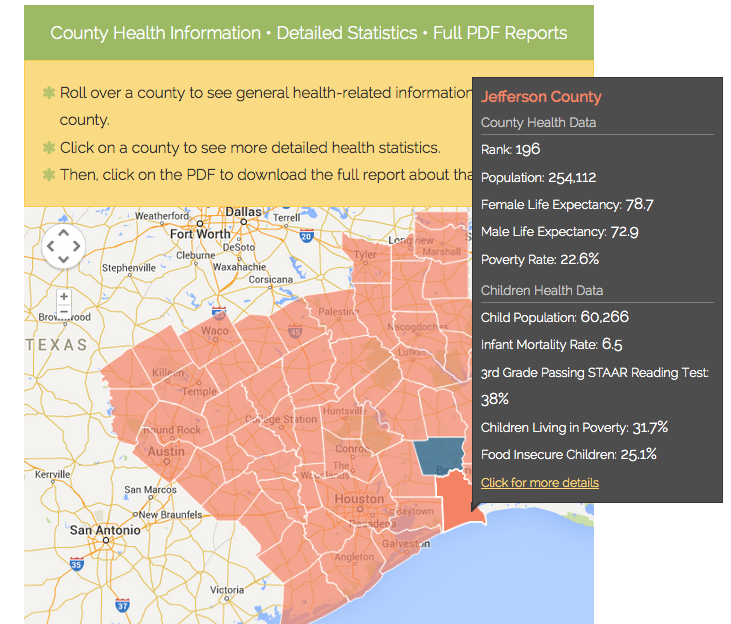Our Research division has compiled new county-level Children’s Health Snapshots to tell the story of the youngest residents in the 57-counties of the Episcopal Diocese of Texas, covering Central, East and Southeast Texas. Each snapshot contains county-specific statistics including infant mortality rates, reading progress, percentage of children living in poverty, and more.
“We compiled this extensive data because it highlights many of the things that affect the health and development of children across the state,” said Dr. Patricia Gail Bray, Vice President for Research at the Foundation. “For many counties, this is the first time this important children’s health information is all in one place.”
EHF researchers used information from more than 30 different data sources to compile each county snapshot. They chose each statistic because of evidence showing an effect on both the long-term and short-term health of children. Some information like infant mortality rates and low birth weight are directly health related. Others indicators like educational milestones and economic factors are linked with health and well-being.
 Dr. Patricia Gail Bray
Dr. Patricia Gail Bray
“For example, the science shows the importance of third-grade reading levels for the health and development of a child,” Bray said. “The same is true for children who are uninsured or those who routinely miss meals.”
Enhancing early childhood development is a key strategy in EHF’s vision of transformation to healthy communities for all. The strategy is based on extensive evidence that there is a window of opportunity early in life when the brain is particularly receptive to positive interventions with long-term impacts.
“We hope people in each county will see this information and start conversations where they live about what they see,” Bray said. “We hope they turn data into action. We believe the numbers can empower communities with the knowledge to decide priorities of change. We look forward to hearing the ideas and partnering with many groups to truly transform children’s health in these communities.”
Where possible, EHF researchers compared each county’s child health indicators to the overall rate for the state. That allows each county to see which of its children’s health statistics are worse than the state average and those that are equal to or better than the average for Texas. The information can also be compared county by county.
County comparisons can be used to highlight what’s working in one county and look at how we can incorporate that knowledge to make an impact in other counties.
With Texas ranked 42nd out of 50 states we realize we have significant work to do to honor the promises of opportunity, equality, health, happiness and prosperity we make to our children. For example:
- Twenty-three of the 57 counties in our Diocese have a higher percentage of children living in poverty than the state average of 27.5%
- Of the 50 counties reporting infant mortality rate, 30 had a higher infant mortality rate than the state average rate of 6.1 out of every 1,000 live births.
- Only 13 of the 57 counties in the Episcopal Diocese of Texas had a higher percentage of third graders passing the STAAR Reading Test than the state average
The Children’s Health Snapshots can be found on our County Health Data section. The section features an interactive map to allow you to view the children’s information along with overall health statistics and rankings for each of the 57 counties in the Episcopal Diocese of Texas.
EHF’s Children’s Health Snapshots include the following counties:
- Anderson County
- Angelina County
- Austin County
- Bastrop County
- Bell County
- Brazoria County
- Brazos County
- Burleson County
- Burnet County
- Chambers County
- Cherokee County
- Colorado County
- Coryell County
- Falls County
- Fayette County
- Fort Bend County
- Freestone County
- Galveston County
- Gregg County
- Grimes County
- Hardin County
- Harris County
- Harrison County
- Houston County
- Jasper County
- Jefferson County
- Lampasas County
- Lee County
- Leon County
- Liberty County
- Limestone County
- Madison County
- Marion County
- Matagorda County
- McLennan County
- Milam County
- Montgomery County
- Nacogdoches County
- Newton County
- Orange County
- Panola County
- Polk County
- Robertson County
- Rusk County
- Sabine County
- San Augustine County
- San Jacinto County
- Shelby County
- Smith County
- Travis County
- Trinity County
- Tyler County
- Walker County
- Waller County
- Washington County
- Wharton County
- Williamson County
